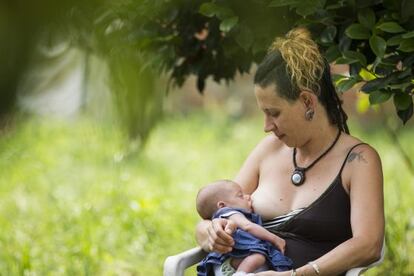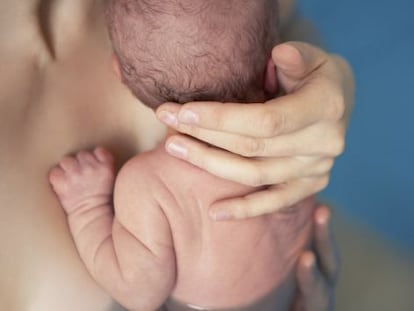The tough task of becoming a mom in crisis-hit Spain
Spanish women are no longer waiting to obtain job security before having their first child

Elvira gave birth to Sara in 1982 when she was 23 and studying for official examinations to become a conservatory music teacher. And now Sara, at age 32, has just given birth to Serea despite having no job security as a kindergarten teacher.
Sara Marcet, a native of the Galician city of Vigo, is a textbook example of the National Statistics Institute (INE)’s profile of the average Spanish mother: a woman who bears children for the first time at the age of 31.8 years, a tenth of a point higher than the previous year.
Sara says she has three friends of a similar age who have also given birth in recent months, and two more who are about to do so. None of them are financially well off, nor do they have any hopes of improving their lot any time in the near future. But they are also not willing to give up on motherhood because of that.
Babies don’t know the difference between a fancy, latest-generation stroller and an ordinary one”
Sara Marcet
According to preliminary data collected by the INE’s 2014 Natural Population Movement report, the number of births rose 0.1% last year from 2013, for a total of 426,303 newborns. This is the first rise after five years of back-to-back drops.
But Teresa Castro, who teaches at the Institute for Economics, Geography and Demographics, a unit of the state-funded Spanish National Research Council (CSIC), says it is too soon to draw any conclusions.
“It would be more accurate to talk about stagnation than about a slight rise,” she says. In economic terms, she notes, this tiny up-tick “reflects nothing.”
“Spain continues to have the lowest birth rates in the world,” adds Castro. “What we might conclude is that as a result of the crisis there has been a decline in birth rates since 2008 in the southern states (Greece, Italy, Spain and Portugal) and in Eastern Europe.”
In 2008, when labor adjustment plans were not yet part of Spaniards’ daily lives, there were 519,779 births in the country, the highest figure in three decades. But after that, numbers declined 18% over the next five years as unemployment and social emergencies soared.
“The most reliable indicator is the fertility rate [the number of estimated children per woman throughout her fertile life],” explains Castro. According to the INE, in 2013 the Spanish fertility rate was 1.27 babies per woman, while in 2014 it was 1.32. Despite the improvement, “it is still well below the levels of France and Norway.” Both of these countries maintained averages of close to two children per woman throughout the crisis.
“We’re the result of other times when people waited for a certain degree of job security before having children,” says Sara Marcet, who has held several jobs over the last few years, most of which had nothing to do with her actual studies. One time she picked apples near the French city of Nantes, and another time she was a magician’s assistant at a circus in Catalonia.
“Now we have seen that this kind of stability is just fiction. You may never have it, or if you do, you could still lose it in the blink of an eye,” continues Marcet. “Women who want to have children, and especially those like me, who want two or three, cannot wait for the clouds to clear. I’ve found the partner I wanted, and I think I am at the best age to start having kids.”
It would be more accurate to talk about stagnation than about a slight rise”
Teresa Castro, demographics scholar
Although the INE figures only reflect averages, academic Teresa Castro believes that the slight rise may be due to the fact that women between 35 and 40 “can no longer wait” to have their first child. After many years of crisis, the biological clock begins to supersede fears about the economic situation.
While the estimated number of children per woman has risen, the number of women of child-bearing age (taken as all women aged between 15 and 49) has fallen from 11.2 million in 2013 to 10.98 million in 2014. The statistics bureau points at causes such as smaller generations born in the 1980s and early 1990s, lower immigration rates (children born to migrants helped push up the birth rates) and more Spaniards moving abroad.
In the meantime, Spanish women keep waiting longer to have their first child. In 1981 the average age was 28.2 years, while in 2014 it was 31.8 years.
“During these years we saw that work is a fragile asset and I think there’s been a change in the way we think,” says Sara Marcet. “Babies don’t know the difference between a fancy, latest-generation stroller and an ordinary one. The most important thing you can give them is not material goods.”
Tu suscripción se está usando en otro dispositivo
¿Quieres añadir otro usuario a tu suscripción?
Si continúas leyendo en este dispositivo, no se podrá leer en el otro.
FlechaTu suscripción se está usando en otro dispositivo y solo puedes acceder a EL PAÍS desde un dispositivo a la vez.
Si quieres compartir tu cuenta, cambia tu suscripción a la modalidad Premium, así podrás añadir otro usuario. Cada uno accederá con su propia cuenta de email, lo que os permitirá personalizar vuestra experiencia en EL PAÍS.
¿Tienes una suscripción de empresa? Accede aquí para contratar más cuentas.
En el caso de no saber quién está usando tu cuenta, te recomendamos cambiar tu contraseña aquí.
Si decides continuar compartiendo tu cuenta, este mensaje se mostrará en tu dispositivo y en el de la otra persona que está usando tu cuenta de forma indefinida, afectando a tu experiencia de lectura. Puedes consultar aquí los términos y condiciones de la suscripción digital.
More information

Birth rate in Spain rises for first time in half a decade
Últimas noticias
Most viewed
- Alain Aspect, Nobel laureate in physics: ‘Einstein was so smart that he would have had to recognize quantum entanglement’
- Alvin Hellerstein, a 92-year-old judge appointed by Bill Clinton, to preside over Maduro’s trial in New York
- Gilles Lipovetsky: ‘If you want to live better and fall in love, take Prozac, don’t look to philosophy’
- Cuba confirms death of 32 of its citizens in the US attack against Venezuela
- Why oil has been at the center of Venezuela-US conflicts for decades








































